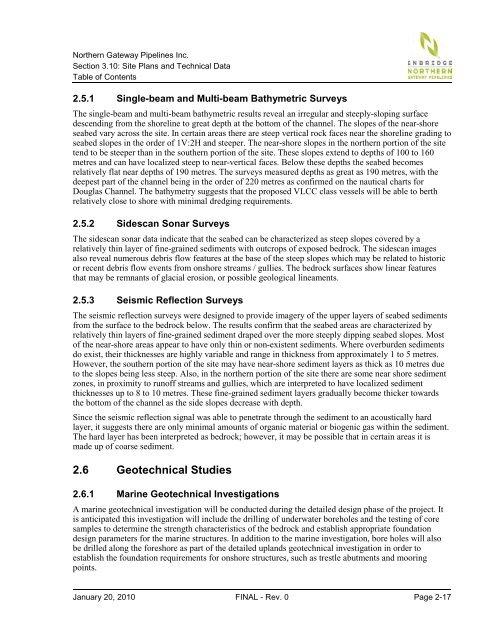Section 3.10: Site Plans and Technical Data - Rick Neufeld Comments
Section 3.10: Site Plans and Technical Data - Rick Neufeld Comments
Section 3.10: Site Plans and Technical Data - Rick Neufeld Comments
Create successful ePaper yourself
Turn your PDF publications into a flip-book with our unique Google optimized e-Paper software.
Northern Gateway Pipelines Inc.<br />
<strong>Section</strong> <strong>3.10</strong>: <strong>Site</strong> <strong>Plans</strong> <strong>and</strong> <strong>Technical</strong> <strong>Data</strong><br />
Table of Contents<br />
2.5.1 Single-beam <strong>and</strong> Multi-beam Bathymetric Surveys<br />
The single-beam <strong>and</strong> multi-beam bathymetric results reveal an irregular <strong>and</strong> steeply-sloping surface<br />
descending from the shoreline to great depth at the bottom of the channel. The slopes of the near-shore<br />
seabed vary across the site. In certain areas there are steep vertical rock faces near the shoreline grading to<br />
seabed slopes in the order of 1V:2H <strong>and</strong> steeper. The near-shore slopes in the northern portion of the site<br />
tend to be steeper than in the southern portion of the site. These slopes extend to depths of 100 to 160<br />
metres <strong>and</strong> can have localized steep to near-vertical faces. Below these depths the seabed becomes<br />
relatively flat near depths of 190 metres. The surveys measured depths as great as 190 metres, with the<br />
deepest part of the channel being in the order of 220 metres as confirmed on the nautical charts for<br />
Douglas Channel. The bathymetry suggests that the proposed VLCC class vessels will be able to berth<br />
relatively close to shore with minimal dredging requirements.<br />
2.5.2 Sidescan Sonar Surveys<br />
The sidescan sonar data indicate that the seabed can be characterized as steep slopes covered by a<br />
relatively thin layer of fine-grained sediments with outcrops of exposed bedrock. The sidescan images<br />
also reveal numerous debris flow features at the base of the steep slopes which may be related to historic<br />
or recent debris flow events from onshore streams / gullies. The bedrock surfaces show linear features<br />
that may be remnants of glacial erosion, or possible geological lineaments.<br />
2.5.3 Seismic Reflection Surveys<br />
The seismic reflection surveys were designed to provide imagery of the upper layers of seabed sediments<br />
from the surface to the bedrock below. The results confirm that the seabed areas are characterized by<br />
relatively thin layers of fine-grained sediment draped over the more steeply dipping seabed slopes. Most<br />
of the near-shore areas appear to have only thin or non-existent sediments. Where overburden sediments<br />
do exist, their thicknesses are highly variable <strong>and</strong> range in thickness from approximately 1 to 5 metres.<br />
However, the southern portion of the site may have near-shore sediment layers as thick as 10 metres due<br />
to the slopes being less steep. Also, in the northern portion of the site there are some near shore sediment<br />
zones, in proximity to runoff streams <strong>and</strong> gullies, which are interpreted to have localized sediment<br />
thicknesses up to 8 to 10 metres. These fine-grained sediment layers gradually become thicker towards<br />
the bottom of the channel as the side slopes decrease with depth.<br />
Since the seismic reflection signal was able to penetrate through the sediment to an acoustically hard<br />
layer, it suggests there are only minimal amounts of organic material or biogenic gas within the sediment.<br />
The hard layer has been interpreted as bedrock; however, it may be possible that in certain areas it is<br />
made up of coarse sediment.<br />
2.6 Geotechnical Studies<br />
2.6.1 Marine Geotechnical Investigations<br />
A marine geotechnical investigation will be conducted during the detailed design phase of the project. It<br />
is anticipated this investigation will include the drilling of underwater boreholes <strong>and</strong> the testing of core<br />
samples to determine the strength characteristics of the bedrock <strong>and</strong> establish appropriate foundation<br />
design parameters for the marine structures. In addition to the marine investigation, bore holes will also<br />
be drilled along the foreshore as part of the detailed upl<strong>and</strong>s geotechnical investigation in order to<br />
establish the foundation requirements for onshore structures, such as trestle abutments <strong>and</strong> mooring<br />
points.<br />
January 20, 2010 FINAL - Rev. 0 Page 2-17
















